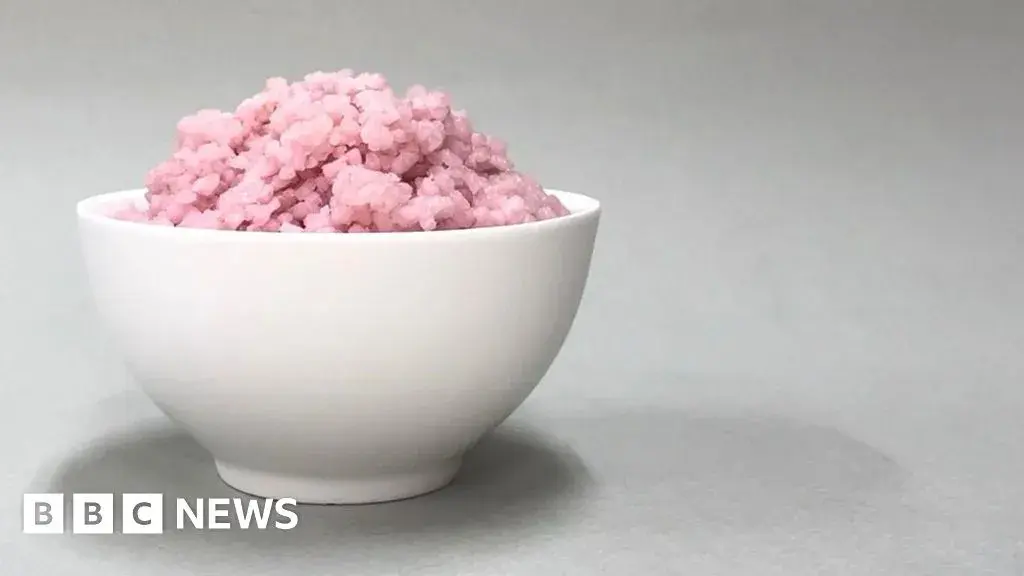paper in question describing this:
A strategy to develop a nutrient-rich hybrid food using rice grains functionalized with nanocoating and bovine cells for a sustainable food system is reported. Rice grains are safe food ingredients with a low incidence of allergy and have a nutritional profile and structure suited for 3D cell culture. An edible coating composed of fish gelatin and food enzymes offers a high affinity between rice grains and cells and improves the structural stability of grains for increased cell capacity. The potential of rice grains as cell scaffolds is demonstrated by investigating the interactions between the coating, grains, and cells. The rice grains are transformed into a hybrid food with animal nutrients by containing organized bovine cells. We discuss the food properties and production value of this rice-based meat to evaluate its potential as a sustainable food that guarantees safety from food crises and global warming.
My first thought was “WTF”, but then I considered the problem. You can grow beef cells, but only easily in a thin layer. So, get something porous but edible, and grow the cells all over it. Rice is just an obvious choice from a culinary perspective.
It’s weird, but I bet cooked up as a burrito or casserole this could actually be appealing, and it’ll be way easier to commercialise than more traditional meat shapes.
Edit: So, here’s Nature on the same. As usual, popsci left out the gotcha, and that’s that there’s not actually a significant amount of beef there. Rice is only slightly porous, just as it seems, I guess.
Once you can eat a hotdog, you can eat anything. Chicken nuggets and surimi are an even worse “meat shape”, yet plenty of people eat them.
“meat shape”
Oh god, did I just coin that? Why did it have to be that?
What meat shapes are your favourites? mine is the token shape as it is easily applicable to bread products.
I’m a vegetarian, lol!
What is your favourite plant then? i like munching on lettuce as a snack, but kiwis are a close second
Definitely some kind of fruit, I love that shit. It’s hard to pick a favourite, but maybe pineapple?
I like pineapple because when you eat it, it eats you; the bromelin starts “digesting” your mouth as soon as you dig in.
So fun. Also nothing else is more delicious than fresh sliced pineapple.
Brassica oleracea
This is very exciting, but also - that picture looks disgusting.
It kinda just looks like ground pork
I see nothing wrong with this. Really curious to try it, actually. Bring it on!
🤖 I’m a bot that provides automatic summaries for articles:
Click here to see the summary
Scientists have created a new type of hybrid food - a “meaty” rice that they say could offer an affordable and eco-friendly source of protein.
The rice was first coated in fish gelatine to help the beef cells latch on, and the grains were left in a petri dish to culture for up to 11 days.
And, compared to regular beef, it has a smaller carbon footprint, since the production method eliminates the need to raise and farm lots of animals.
Since the first lab-grown burger was unveiled in London in 2013, dozens of companies around the world have joined the race to bring affordable cultivated meat to the market.
Prof Neil Ward, an agri-food and climate specialist at the University of East Anglia, said this type of research holds promise for the development of healthier and more climate-friendly diets in future, but that some people needed convincing.
Bridget Benelam from the British Nutrition Foundation said: "Developing a diet that supports health for both people and planet is a major challenge.
Saved 69% of original text.
So it’s Soylent pink! I bet that’s delicious if you put it in the smoker.
deleted by creator
It’s interesting that they went bovine when India is one of the largest consumers of rice but Hindus don’t eat beef. Chicken or fish would be more universal.






